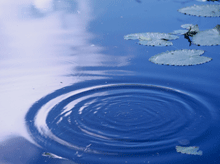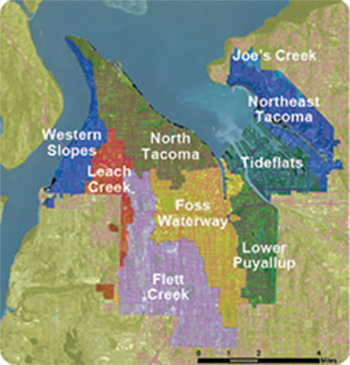
Tacoma's Stormwater System
Tacoma averages 40 inches of rain a year. You may not see a direct path from your home to the Puget Sound, but you can bet the rainwater from where you live will end up in the Puget Sound or a local lake or stream – carrying with it pollutants it picks up along the way.
How does this rainwater travel to the Puget Sound? In most cases, the water trickles down your gutters, runs down your driveway or off your lawn, rounds the curb and heads down the street until it hits a catch basin and drops out of sight.
That water may be out of sight, but it shouldn’t be out of mind. Unlike wastewater, stormwater doesn’t get treated before it enters our waterways. It’s important that it doesn’t pick up pollutants on your driveway or lawn before it heads down the storm drain. Learn more about preventing water pollution.
Catch Basins
The water’s first stop into the stormwater system is a catch basin. Tacoma has more than 18,000 catch basins that are designed to “catch” the big pieces of debris such as garbage and leaves that wash into the catch basin.
Help us keep garbage, debris and leaves out of your neighborhood catch basins because when they get clogged, it causes flooding. You can help remind others that catch basins lead to streams and Puget Sound – participate in the next catch basin marking event.
Pump Stations Keep the Water Moving and Prevent Flooding
Once through a catch basin, the water travels through any part of the more than 500 miles of stormwater pipe in Tacoma. The pipes carry stormwater to our local waterways.
In lower areas where the water would settle, there are surface water pump stations, which help prevent flooding by moving the water.
There are 13 stormwater pump stations in Tacoma located in four areas:
| Flett Creek |
3 |
10,125 |
| Leach Creek |
4 |
11,000 |
|
Landfill
|
2
|
105
|
|
|
|
|
Holding Basins Store Water During Heavy Rains
Especially during the winter months, the Northwest is notorious for rain. To help prevent flooding the City of Tacoma has holding basins, or detention ponds, that collect and hold water flowing from our neighborhoods.
Since water flows downhill, our system also collects water from other municipalities, including Pierce County, Fife, Lakewood, the Port of Tacoma and highway runoff from the Washington State Department of Transportation.
Our Stormwater Does Not Get Treated, So Keep It Clean!
Storm drains, catch basins, pump stations, detention ponds – these pieces make up a complex surface water system. This system prevents flooding and gets that water from your lawn to the Puget Sound. These systems aren’t able to treat, or clean up the water, so it’s up to us to keep our water clean before it ends up being a home for our fish.
 Tacoma's Watersheds
Tacoma's Watersheds
Tacoma is made up of nine sub-watersheds or smaller subdivisions of larger surrounding watersheds.
North Tacoma
North Tacoma is a subwatershed of the Puyallup and Clover-Chambers Creek watersheds. Covering 4,766 acres in north Tacoma this subwatershed is mostly residential, but contains the 6th Avenue, Proctor District and Ruston Way commercial areas and parts of the Westgate Shopping Center. It also includes the North End Treatment Plant and former Asarco smelting site.
This North Tacoma subwatershed flows into these bodies of water:
- Commencement Bay
- Ruston Creek
- Asarco Creek
- Puget Creek
- Mason Creek
- The stream associated with Garfield Gulch
The City of Tacoma, the Port of Tacoma and the Commencement Bay Cleanup Action Committee, along with other community groups, have worked together to improve fish access and plant cover along Puget Creek. Salmon fry were released into the stream in 1994 and 1998, and a fish ladder was built in 1997 to give fish access to the creek. Learn more about Tacoma’s Salmon.
Foss Waterway
Foss Waterway is a subwatershed of the Puyallup watershed. Covering 5,781 acres in south-central Tacoma this subwatershed is mostly residential but contains Tacoma’s industrial businesses located in the Tideflats and Nalley Valley.
The Thea Foss and Wheeler-Osgood waterways became designated Superfund cleanup sites in 1983. Waterway cleanup and construction was finished in 2006. The City will monitor the waterway for the next 10 years. Learn more about the Thea Foss Waterway Cleanup.
T-Street and Lower Puyallup
The T-Street/Lower Puyallup is a subwatershed of the Puyallup watershed. Located in southeast Tacoma this subwatershed covers 2,971 acres. The southern part of the subwatershed is mostly residential with some undeveloped open space and a few small commercial areas, while the northern part of the subwatershed contains industrial and commercial areas.
This T-Street/Lower Puyallup subwatershed drains into these bodies of water:
- Puyallup River
- Swan Creek
- T Street Gulch
The Puyallup River, with its tributaries, serves as a major migration route for a variety of salmonid species. Four fish hatcheries are located in this system upstream from Tacoma. The lower Puyallup, where it meets Commencement Bay, is a salt-wedge estuary, with deeper marine water covered by a layer of fresh water. Learn more about Tacoma’s Salmon.
Swan Creek was part of a 12-acre restoration project that was completed by the City of Tacoma in 2001. Learn more about the Swan Creek restoration project.
Tideflats
The Tideflats is subwatershed of the Puyallup watershed. Covering 2,112 acres the Tideflats is the most highly industrial and commercial section of Tacoma.
The Tideflats subwatershed drains into these bodies of water:
- Sitcum Waterway
- Blair Waterway
- Hylebos waterways
Hylebos Creek discharges into the head of the Hylebos Waterway and Wapato Creek discharges into the head of the Blair Waterway. The lower portions of these creeks are in Tacoma. The Milwaukee Waterway was filled and capped from 1993-1995. The Sitcum and Hylebos waterways have been identified as Superfund cleanup sites. Learn more about the Hylebos Waterway restoration project.
Northeast Tacoma
Northeast Tacoma is a subwatershed within the Commencement Bay watershed. Covering 2,641 acres, this subwatershed is mostly residential that has recently become the fastest growing area in the city. Many large residential developments, as well as shopping areas to support them, have been built or are under development.
Western Slopes
Western Slopes is a subwatershed of the Clover-Chambers Creek watershed. Covering 2,090 acres Western Slopes is located in northwest Tacoma. Although mostly residential with steep slopes it also contains part of the 6th Avenue commercial area as well as Point Defiance Park.
Underground springs and near surface groundwater are characteristic of the steep slopes in this area. The Western Slopes subwatershed drains directly to the Narrows Passage via two small creeks - Gold Creek and Narrows Creek.
Leach Creek
Leach Creek is a subwatershed of the Clover-Chambers Creek watershed. Located in the west-central part of Tacoma, Leach Creek covers 1,728 acres and contains both residential and commercial land.
Water from the Leach Creek subwatershed drains to the Leach Creek holding basin, which discharges into Leach Creek, a highly urbanized stream. Leach Creek flows into Chambers Creek. Good salmonid spawning habitat may be found in the lower portion of the creek from Bridgeport Way to Chambers Creek. The upper portions of the creek contain pockets of spawning grounds, but the elimination of vegetation by homeowners, the channeling of water and storm-related erosion, have had a negative impact on the spawning area. Learn more about Tacoma’s Salmon. The Stream Team has conducted water quality monitoring along the stream.
Flett Creek
Flett Creek covers 7,153 acres and is the second largest subwatershed in Tacoma and is mostly residential with light commercial and industrial areas.
Flett Creek subwatershed flows into Snake Lake and Wapato Lake. The Flett Creek surface water drains through a series of holding basins, including Hosmer, Ward’s Lake, a gravel holding basin just north of Ward’s Lake and the four Flett Creek holding basins in the west. At the last Flett Creek holding basin a pump station sends the water to the Flett Dairy wetlands, where it flows into Flett Creek. Downstream, Flett Creek flows into Chambers Creek, a salmonid-bearing stream, which discharges into Chambers Bay then to the Narrows.
Clover Park Technical College set aside a large amount of the Flett Dairy wetland to be preserved as open space and to provide for student training in water quality and environmental investigations and sampling.
Joe’s Creek
Joe’s Creek subwatershed covers only 157 acres making it the smallest in Tacoma. It contains mostly single and multiple-family homes with some open space and undeveloped land.
Most of Joe’s Creek is in Federal Way, where it discharges into Puget Sound at Dumas Bay. The lower part of the creek is used by salmonid species. While this use is moderate, the lowermost portion of the creek provides the largest and best quality reach of salmonids spawning and rearing habitat in the southwest portion of King County. This habitat is threatened by sediment and trash deposits.